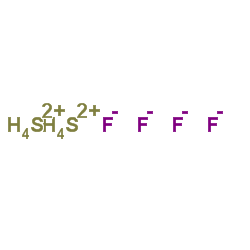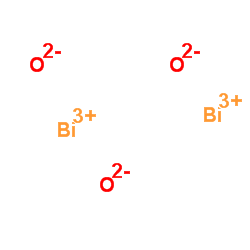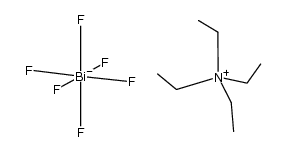Bismuth(III) Fluoride
Modify Date: 2024-01-02 19:11:07

Bismuth(III) Fluoride structure
|
Common Name | Bismuth(III) Fluoride | ||
|---|---|---|---|---|
| CAS Number | 7787-61-3 | Molecular Weight | 265.97600 | |
| Density | 8.3 | Boiling Point | 900℃ | |
| Molecular Formula | BiF3 | Melting Point | 727ºC | |
| MSDS | Chinese USA | Flash Point | N/A | |
| Symbol |

GHS05 |
Signal Word | Danger | |
| Name | Bismuth(III) Fluoride |
|---|---|
| Synonym | More Synonyms |
| Density | 8.3 |
|---|---|
| Boiling Point | 900℃ |
| Melting Point | 727ºC |
| Molecular Formula | BiF3 |
| Molecular Weight | 265.97600 |
| Exact Mass | 265.97600 |
| LogP | 1.26060 |
| Index of Refraction | 1.74 |
Synonym: Section 2 - COMPOSITION, INFORMATION ON INGREDIENTS
Risk Phrases: None Listed. Section 3 - HAZARDS IDENTIFICATION EMERGENCY OVERVIEW
The toxicological properties of this material have not been fully investigated. Potential Health Effects Eye: No information regarding eye irritation and other potential effects was found. Skin: No information regarding skin irritation and other potential effects was found. Ingestion: The toxicological properties of this substance have not been fully investigated. Inorganic fluorides can be harmful. Acute exposure to fluorine compounds can lead to digestive tract burns, and abdominal pain. May cause fever and rheumatic pain. Inhalation: The toxicological properties of this substance have not been fully investigated. Chronic: Chronic inhalation and ingestion may cause chronic fluoride poisoning (fluorosis) characterized by weight loss, weakness, anemia, brittle bones, and stiff joints. Repeated or prolonged exposure may cause a bismuth line or black spots on the gums, foul breath and salivation. Chronic exposure to fluoride compounds may cause systemic toxicity. Section 4 - FIRST AID MEASURES Eyes: Flush eyes with plenty of water for at least 15 minutes, occasionally lifting the upper and lower eyelids. Get medical aid immediately. Skin: Get medical aid. Flush skin with plenty of water for at least 15 minutes while removing contaminated clothing and shoes. Ingestion: If victim is conscious and alert, give 2-4 cupfuls of milk or water. Never give anything by mouth to an unconscious person. Get medical aid immediately. Inhalation: Get medical aid immediately. Remove from exposure and move to fresh air immediately. If breathing is difficult, give oxygen. Notes to Physician: Section 5 - FIRE FIGHTING MEASURES General Information: Not available. Extinguishing Media: Not available. Section 6 - ACCIDENTAL RELEASE MEASURES General Information: Use proper personal protective equipment as indicated in Section 8. Spills/Leaks: Sweep up or absorb material, then place into a suitable clean, dry, closed container for disposal. Section 7 - HANDLING and STORAGE Handling: Wash thoroughly after handling. Use only in a well-ventilated area. Avoid contact with eyes, skin, and clothing. Avoid ingestion and inhalation. Storage: Store in a cool, dry place. Store in a tightly closed container. Section 8 - EXPOSURE CONTROLS, PERSONAL PROTECTION Engineering Controls: Use adequate ventilation to keep airborne concentrations low. Exposure Limits CAS# 7787-61-3: Personal Protective Equipment Eyes: Wear appropriate protective eyeglasses or chemical safety goggles as described by OSHA's eye and face protection regulations in 29 CFR 1910.133 or European Standard EN166. Skin: Wear appropriate protective gloves to prevent skin exposure. Clothing: Wear appropriate protective clothing to prevent skin exposure. Respirators: Follow the OSHA respirator regulations found in 29 CFR 1910.134 or European Standard EN 149. Use a NIOSH/MSHA or European Standard EN 149 approved respirator if exposure limits are exceeded or if irritation or other symptoms are experienced. Section 9 - PHYSICAL AND CHEMICAL PROPERTIES Physical State: Crystals Color: white to gray Odor: Not available. pH: Not available. Vapor Pressure: Not available. Viscosity: Not available. Boiling Point: Not available. Freezing/Melting Point: Not available. Autoignition Temperature: Not available. Flash Point: Not available. Explosion Limits, lower: Not available. Explosion Limits, upper: Not available. Decomposition Temperature: Solubility in water: Practically insoluable Specific Gravity/Density: Molecular Formula: BiF3 Molecular Weight: 265.9792 Section 10 - STABILITY AND REACTIVITY Chemical Stability: Stable under normal temperatures and pressures. Conditions to Avoid: Moisture, excess heat. Incompatibilities with Other Materials: Strong oxidizing agents, strong acids. Hazardous Decomposition Products: Hydrogen fluoride gas. Hazardous Polymerization: Has not been reported Section 11 - TOXICOLOGICAL INFORMATION RTECS#: CAS# 7787-61-3 unlisted. LD50/LC50: Not available. Carcinogenicity: Bismuth (III) Fluoride - Not listed by ACGIH, IARC, or NTP. Section 12 - ECOLOGICAL INFORMATION Section 13 - DISPOSAL CONSIDERATIONS Dispose of in a manner consistent with federal, state, and local regulations. Section 14 - TRANSPORT INFORMATION IATA Not regulated as a hazardous material. IMO Not regulated as a hazardous material. RID/ADR Not regulated as a hazardous material. Section 15 - REGULATORY INFORMATION European/International Regulations European Labeling in Accordance with EC Directives Hazard Symbols: Not available. Risk Phrases: Safety Phrases: WGK (Water Danger/Protection) CAS# 7787-61-3: No information available. Canada CAS# 7787-61-3 is listed on Canada's NDSL List. CAS# 7787-61-3 is not listed on Canada's Ingredient Disclosure List. US FEDERAL TSCA CAS# 7787-61-3 is listed on the TSCA inventory. SECTION 16 - ADDITIONAL INFORMATION N/A |
| Symbol |

GHS05 |
|---|---|
| Signal Word | Danger |
| Hazard Statements | H314 |
| Precautionary Statements | P260-P280-P303 + P361 + P353-P304 + P340 + P310-P305 + P351 + P338 |
| Personal Protective Equipment | Eyeshields;Faceshields;full-face particle respirator type N100 (US);Gloves;respirator cartridge type N100 (US);type P1 (EN143) respirator filter;type P3 (EN 143) respirator cartridges |
| Hazard Codes | C |
| Risk Phrases | 34 |
| Safety Phrases | 26-36/37/39-45 |
| RIDADR | UN 3260 8/PG 2 |
| WGK Germany | 3 |
| Packaging Group | III |
| Precursor 10 | |
|---|---|
| DownStream 4 | |
| EINECS 232-124-8 |
| trifluorobismuthane |
| MFCD00010893 |
 CAS#:7783-60-0
CAS#:7783-60-0 CAS#:1304-76-3
CAS#:1304-76-3 CAS#:7664-39-3
CAS#:7664-39-3 CAS#:7787-62-4
CAS#:7787-62-4 CAS#:7782-50-5
CAS#:7782-50-5 CAS#:7440-69-9
CAS#:7440-69-9 CAS#:7782-41-4
CAS#:7782-41-4 CAS#:13847-65-9
CAS#:13847-65-9![11-cyclohexyl-5-(((perfluorooctyl)sulfonyl)oxy)-5,10,11,12-tetrahydro-5l5-benzo[c]benzo[3,4][1,2]azabismolo[1,2-a][1,2]azabismol-11-ium Structure](https://www.chemsrc.com/caspic/492/1186323-72-7.png) CAS#:1186323-72-7
CAS#:1186323-72-7 CAS#:126844-35-7
CAS#:126844-35-7 CAS#:14521-18-7
CAS#:14521-18-7 CAS#:13520-72-4
CAS#:13520-72-4